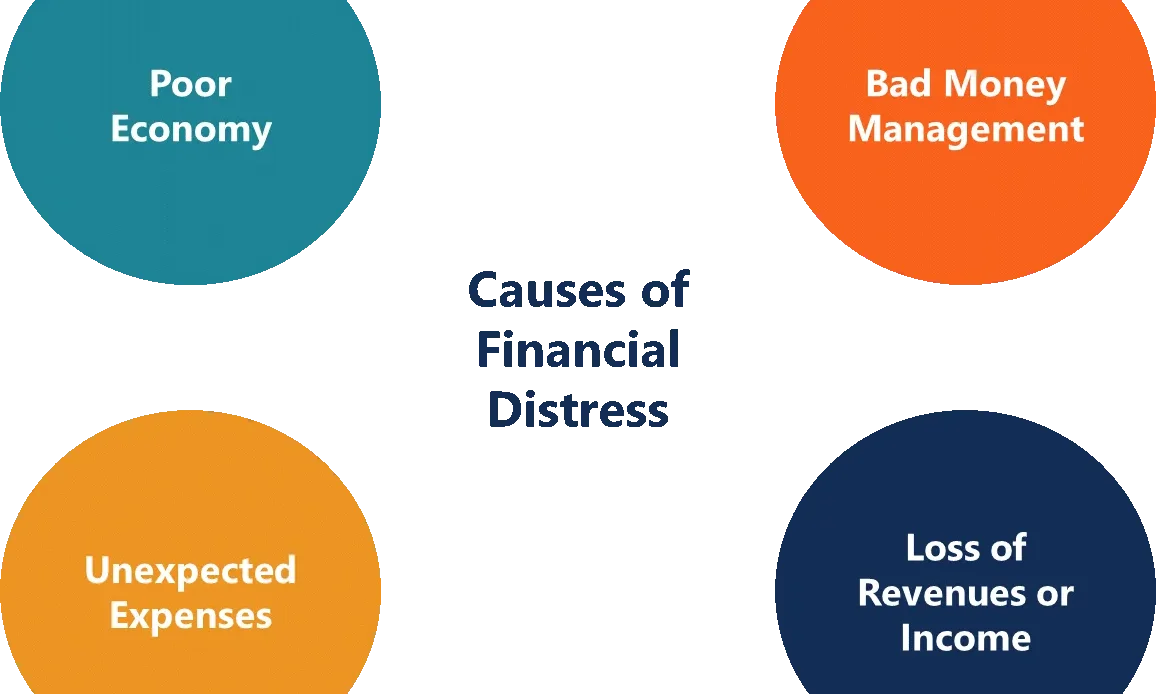
Proven Strategies for Managing Financial Distress: Navigating Challenges with Effective Solutions
Introduction
Financial distress can be a formidable challenge for businesses and individuals alike, often manifesting as a result of declining revenues, increased debt, or unforeseen economic pressures. Effectively managing financial distress is crucial for stabilizing operations, maintaining solvency, and paving the way for recovery. This article explores comprehensive strategies for managing financial distress, offering practical solutions and insights to guide businesses and individuals through turbulent financial times.
In the volatile world of business and personal finance, financial distress is an increasingly common experience that affects individuals, small businesses, and large corporations alike. Whether it’s caused by sudden market downturns, poor cash flow management, excessive debt, or unforeseen crises such as pandemics or economic recessions, the ramifications of financial distress can be both immediate and long-lasting. However, it’s important to understand that financial distress does not have to mark the end of the road. With the right tools, insights, and most importantly—proven strategies, individuals and organizations can not only survive financial distress but emerge stronger, more resilient, and better prepared for the future.
Managing financial distress is not a one-size-fits-all endeavor. It requires a keen understanding of the unique factors that have contributed to the situation, a realistic appraisal of available resources, and a carefully crafted recovery plan. At its core, it’s about regaining control—controlling your cash flow, expenses, liabilities, and financial decision-making processes. In today’s complex economic climate, where change is both constant and disruptive, the ability to adapt and respond with precision is the key to long-term stability.
The term “financial distress” may conjure images of failing companies, foreclosure signs, and overwhelmed individuals. However, it’s essential to de-stigmatize this concept and recognize that financial distress is a challenge, not a failure. It signals a moment of reckoning—a time to pause, reflect, and take strategic action. The good news is that through sound financial restructuring, stakeholder engagement, debt negotiation, and professional advisory support, financial distress can be managed effectively.
For businesses, signs of financial distress might include declining profits, missed loan payments, employee layoffs, or increasing creditor pressure. For individuals, it might look like maxed-out credit cards, mounting bills, or late mortgage payments. In both cases, the stress can be paralyzing, often leading to poor financial choices. But by embracing proven, data-driven strategies, one can transition from a reactive stance to a proactive recovery process.
One of the most important aspects of managing financial distress is early detection and intervention. The earlier the warning signs are identified, the more options are available for course correction. Businesses can conduct cash flow analyses, monitor liquidity ratios, and engage with lenders before defaults occur. Individuals can create structured repayment plans and seek financial counseling before debt spirals out of control. In many cases, financial distress becomes unmanageable simply because it is ignored or misunderstood until it is too late.
This article delves into the most reliable and effective strategies for managing financial distress, focusing on both business and personal finance. We will explore debt restructuring, operational efficiency, cost management, stakeholder negotiations, legal protections, and mental resilience—all tools in the arsenal of recovery. Real-life examples, industry best practices, and expert insights will help illuminate a pathway toward financial health.
Moreover, this article will not shy away from the emotional and psychological dimensions of financial distress. It is not merely a numbers problem. It impacts mental health, relationships, productivity, and quality of life. Therefore, any strategy that aims to combat financial distress must be holistic and human-centered. We will also explore how to create financial habits that prevent future distress and encourage long-term success.
Whether you are a business owner facing cash flow issues, a young professional drowning in debt, or a corporate leader steering your firm through turbulent waters, the knowledge and strategies outlined in this guide are designed to offer clarity, hope, and direction. Financial recovery is not only possible—it is probable, provided you equip yourself with the right mindset and actionable plan.
As we navigate the complexities of financial distress together, let this be the beginning of a strategic transformation, rather than a breakdown. The goal is not just to survive, but to thrive. The first step is recognizing the problem. The second is believing it can be solved. And the third is applying proven strategies with unwavering determination.
Let’s begin.
1. Understanding Financial Distress
Financial distress occurs when an individual or organization struggles to meet financial obligations and maintain operational stability. Common indicators of financial distress include mounting debts, cash flow problems, and declining profitability. Addressing these issues proactively is essential to avoid more severe consequences, such as bankruptcy or insolvency.
2. Assessing the Situation
The first step in managing financial distress is a thorough assessment of the current financial situation. This involves:
Conducting a Financial Review:
Analyze financial statements, cash flow reports, and budget forecasts to gain a clear understanding of the financial position. Identifying key areas of concern, such as high debt levels or negative cash flow, provides a foundation for developing effective strategies.Identifying Root Causes:
Determine the underlying causes of financial distress, which may include declining sales, increased operational costs, poor financial management, or external economic factors. Understanding these causes helps in formulating targeted solutions.Engaging with Stakeholders:
Communicate with key stakeholders, including creditors, investors, and employees, to gather insights and gauge their perspectives. Effective communication fosters transparency and can lead to collaborative solutions.
3. Developing a Financial Recovery Plan
Creating a detailed financial recovery plan is critical for addressing financial distress and steering towards stability. Key components of a financial recovery plan include:
Cost Reduction:
Identify and implement cost-saving measures to reduce operational expenses. This may involve renegotiating contracts, reducing discretionary spending, or streamlining operations. Cost reduction should be balanced to avoid compromising essential business functions.Revenue Enhancement:
Explore strategies to boost revenue, such as diversifying product offerings, entering new markets, or increasing sales efforts. Enhancing revenue streams helps improve cash flow and overall financial health.Debt Restructuring:
Negotiate with creditors to restructure existing debt, which may involve extending repayment terms, reducing interest rates, or converting debt to equity. Effective debt restructuring can alleviate immediate financial pressure and improve liquidity.Operational Efficiency:
Assess and optimize operational processes to enhance efficiency and productivity. Implementing best practices, adopting technology solutions, and improving supply chain management can contribute to cost savings and operational improvements.Cash Flow Management:
Develop a robust cash flow management strategy to ensure timely payment of obligations and maintain liquidity. This includes monitoring cash flow regularly, managing receivables and payables, and maintaining an adequate cash reserve.
4. Seeking Professional Advice
Engaging professional advisors is crucial for effectively managing financial distress. Professionals such as financial consultants, legal advisors, and restructuring experts can provide valuable guidance, including:
Financial Consultants:
Financial consultants can offer expertise in developing recovery plans, analyzing financial data, and implementing cost-saving measures. Their insights help ensure that strategies are well-informed and effective.Legal Advisors:
Legal advisors assist in navigating legal aspects of financial distress, including debt restructuring, bankruptcy proceedings, and regulatory compliance. Their expertise helps manage legal risks and ensure compliance with applicable laws.Restructuring Experts:
Restructuring experts specialize in developing and executing restructuring plans. They can assist in negotiating with creditors, managing operational changes, and implementing turnaround strategies.
5. Implementing and Monitoring Strategies
Once strategies are developed, it is essential to implement them effectively and monitor progress:
Action Plan Execution:
Execute the financial recovery plan according to the outlined strategies. Ensure that all necessary steps are taken, including cost reductions, revenue enhancements, and debt restructuring.Progress Monitoring:
Regularly monitor financial performance and progress towards recovery goals. This involves reviewing financial statements, tracking cash flow, and assessing the effectiveness of implemented strategies.Adjustments and Adaptations:
Be prepared to make adjustments to the recovery plan as needed. Financial conditions and business environments can change, requiring adaptations to ensure continued progress and stability.
6. Communicating with Stakeholders
Effective communication with stakeholders is key to managing financial distress:
Transparent Updates:
Provide regular updates to stakeholders regarding the financial situation, recovery efforts, and progress. Transparency fosters trust and collaboration.Negotiation and Collaboration:
Engage in negotiations with creditors and investors to gain support for recovery plans. Collaborative efforts can lead to favorable terms and facilitate the resolution of financial challenges.
7. Building for the Future
Managing financial distress is not only about addressing current challenges but also preparing for future success:
Risk Management:
Implement risk management practices to mitigate potential future financial risks. This includes diversifying revenue streams, maintaining adequate reserves, and monitoring market trends.Strategic Planning:
Develop long-term strategic plans that align with the organization’s goals and market conditions. Strategic planning helps ensure sustainable growth and resilience against future financial challenges.Continuous Improvement:
Foster a culture of continuous improvement within the organization. Regularly review and refine processes, seek innovation opportunities, and remain adaptable to changing conditions.
8. Conclusion
Navigating financial distress requires a proactive and strategic approach to addressing immediate challenges and laying the groundwork for long-term stability. By conducting a thorough assessment, developing a comprehensive recovery plan, seeking professional advice, and implementing effective strategies, businesses and individuals can manage financial distress effectively and emerge stronger. Transparent communication with stakeholders and a focus on future growth further enhance the likelihood of successful resolution and sustainable success. As financial landscapes continue to evolve, staying informed and adaptable is key to overcoming financial challenges and achieving enduring financial health.
The journey through financial distress is undoubtedly one of the most challenging experiences anyone—whether an individual, a startup, or a multinational corporation—can face. However, it is also one of the most transformative. It is during such periods of turbulence that strategic thinking, resilience, and resourcefulness are most required and most rewarded. As we have explored throughout this article, the key to navigating financial distress lies in understanding the root causes, implementing time-tested solutions, and staying disciplined in execution.
One of the most empowering realizations is that financial distress is manageable. Through comprehensive financial planning, active debt negotiation, cost containment, and stakeholder engagement, it is possible to regain control and prevent further decline. While the challenges may seem overwhelming initially, a step-by-step approach rooted in financial intelligence and ethical decision-making can make all the difference. The key takeaway is this: you are not powerless. With the right strategy, you can shift the tide in your favor.
For businesses, this could mean restructuring operations, re-negotiating vendor contracts, seeking bridge financing, or even considering formal insolvency procedures when necessary. But it doesn’t end there—recovery includes implementing stronger corporate governance, improving financial transparency, and building robust risk management systems that protect against future shocks. Businesses that successfully emerge from financial distress often find themselves stronger and more competitive because the process compels them to innovate and optimize.
For individuals, managing financial distress might involve credit counseling, budgeting, or consolidation loans. But more than that, it’s about shifting the mindset—learning from past financial behavior and cultivating a disciplined, forward-thinking approach. The development of healthy financial habits such as saving regularly, avoiding high-interest debt, and planning for emergencies can act as a shield against future financial turmoil.
It’s also worth noting that professional advice is invaluable. Financial advisors, insolvency practitioners, and legal consultants provide guidance that is both strategic and compliant with the laws governing debt and insolvency in your jurisdiction. Their expertise can fast-track recovery and help avoid costly mistakes.
One crucial, often overlooked aspect of financial distress is the human side—the toll it takes on emotional and psychological well-being. The anxiety, stress, and social stigma associated with financial hardship can paralyze decision-making and reduce morale. That’s why any strategy for overcoming financial distress must also include mental wellness, support networks, and counseling where needed. A healthy mind makes for healthier financial choices.
Furthermore, emerging technologies and financial tools now offer greater access to budgeting apps, debt management platforms, and forecasting software that provide real-time insight into your financial status. These tools can empower users to take corrective action faster than ever before. Leveraging such technologies is not just advisable—it’s necessary in the digital age of finance.
In closing, financial distress is not a permanent condition. It is a stage—temporary, albeit difficult—that can be overcome with the right mindset, methods, and support. What sets successful recoveries apart is the willingness to take decisive action, the humility to seek help, and the perseverance to keep pushing forward despite setbacks.
This article aimed to present a balanced, realistic, and actionable approach to managing financial distress. Whether you’re currently experiencing hardship or proactively preparing for potential downturns, the strategies detailed here are grounded in real-world success and expert validation. They are proven to work—not by theory, but by practice.
Your next step? Act. Don’t delay the conversation. Don’t postpone the assessment. The sooner you act, the more options remain on the table. Financial freedom begins with financial clarity, and clarity begins with informed decision-making.
Let these strategies guide you out of distress and into a new era of stability, growth, and peace of mind. Remember, in every crisis lies the seed of opportunity. It’s time to plant that seed and grow.
Beyond recovery, the true power in managing financial distress lies in the ability to build long-term financial resilience. Once the storm has passed, it’s essential not to revert to old patterns. Instead, consider financial distress as a crucial turning point—a wake-up call that encourages strategic transformation, continuous learning, and financial discipline.
To fortify against future financial turbulence, institutionalizing financial best practices is vital. For businesses, this includes setting up strong internal controls, investing in financial training for management teams, and integrating contingency planning into core operations. It may also involve building diverse income streams to cushion against volatility in any one area. For individuals, this could mean setting up an emergency fund, committing to ongoing financial literacy, and avoiding high-risk investments without adequate research or advisory input.
One significant component of post-distress recovery is reputation management. For companies, financial hardship can lead to a loss of credibility with stakeholders—clients, suppliers, creditors, and even employees. Restoring that trust takes time and intentional effort. Transparency is crucial. By openly communicating your recovery journey, the lessons learned, and your forward strategy, you can gradually rebuild your public and professional image.
Moreover, policy and governance reforms often play a crucial role in ensuring a successful post-distress era. Companies should revisit their corporate governance frameworks, ensuring checks and balances are not just present but functional. This includes defining clear financial oversight roles and improving the quality of board-level financial discussions. For individuals, it might mean redefining personal goals and aligning their finances with those goals, supported by periodic reviews.
Importantly, don’t underestimate the value of support systems. Peer networks, accountability partners, financial advisors, and mentors can offer insight, perspective, and encouragement when self-doubt creeps in. Financial distress often isolates people emotionally and socially. Rebuilding confidence takes more than spreadsheets—it takes community and encouragement. Reach out, seek professional guidance, and surround yourself with those who support your comeback story.
In an ever-changing economic environment, no strategy is truly future-proof. But agility, financial intelligence, and resilience can keep you ahead of many pitfalls. By remaining vigilant—tracking performance metrics, staying current with market trends, and maintaining open lines of financial communication—you create a strong buffer against future downturns.
Finally, allow yourself to celebrate small victories. Each debt cleared, each quarter of profitability, each personal milestone is proof of progress. Financial recovery isn’t about perfection; it’s about progression. Measuring and celebrating these wins reinforces positive behaviors and keeps motivation high.
To sum up, overcoming financial distress requires more than reactive problem-solving—it calls for proactive evolution. From understanding root causes to implementing lasting reforms, the goal isn’t merely to return to baseline, but to rise above it with a new level of clarity, capability, and confidence. You have the power not only to recover but to transform your financial future.
Financial distress is not your identity—it’s your challenge. And with proven strategies and a resolute mindset, it’s a challenge you’re well-equipped to overcome.
Contact Us
For premier legal research services in Insolvency and Bankruptcy law cases in Nigeria, contact Chaman Law Firm today. Our offices are conveniently located in Lagos, FCT Abuja, Ogun State, and the UK. We are readily available to assist you with your legal needs. Whether you require consultation, representation, or ongoing legal support, Chaman Law Firm is your trusted partner in navigating Insolvency and Bankruptcy in Nigeria.
Call us at 08065553671 or email us at info@chamanlawfirm.com to schedule a consultation.
- Corporate Insolvency and Liquidation
- Debt Restructuring and Workouts
- Bankruptcy Proceedings for Individuals
- Creditor Rights and Claims
- Cross-Border Insolvency
Chaman Law Firm: Your Trusted Legal Partner in Insolvency and Bankruptcy Law
By choosing Chaman Law Firm, you are selecting a team of dedicated professionals committed to providing exceptional Insolvency and Bankruptcy Law legal services tailored to your unique needs. Let us be your advocate and guide in the complex world of Insolvency and Bankruptcy law, ensuring your interests are protected and your goals are achieved.


